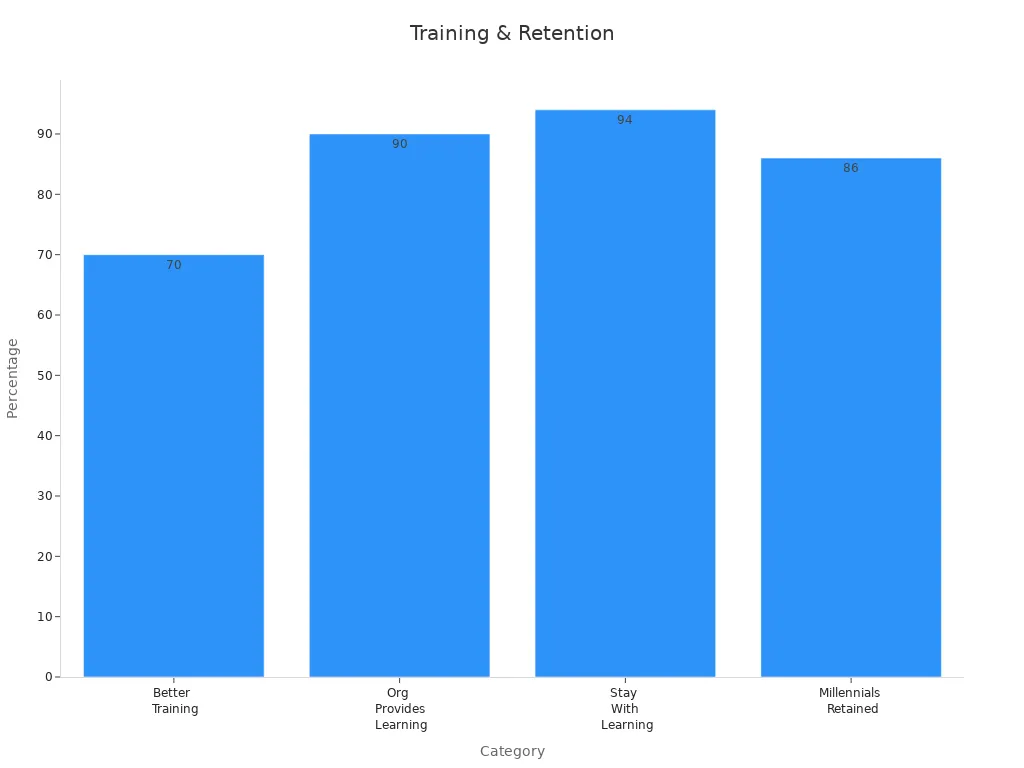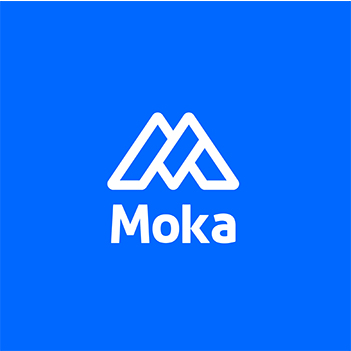How AI Drives Effective Employee Upskilling and Reskilling

AI reshapes how you approach employee upskilling and reskilling. It identifies skill gaps, predicts future needs, and personalizes training. For example, executives estimate that 40% of the workforce will need reskilling within three years. AI also enhances workforce agility, helping employees adapt to rapid technological changes. This agility boosts organizational success by addressing challenges like declining engagement, which dropped to 30% in early 2024. The Role of AI in Employee Upskilling & Reskilling ensures your team stays competitive and prepared for evolving demands.
Key Takeaways
AI finds skill gaps in workers, helping focus training better.
AI makes personal learning plans that keep workers interested longer.
Using AI for learning helps your team handle future changes easily.
Leaders are key to using AI, encouraging growth and new ideas.
Add AI tools to training now to improve and stay ahead.
The Importance of Upskilling and Reskilling in the Modern Workforce
Adapting to Technological Advancements
Technology evolves rapidly, reshaping industries and creating new job roles. You must adapt to these changes to remain competitive. The World Economic Forum predicts that by 2025, half of all employees will need reskilling due to increased technology adoption. Automation and AI are expected to create 69 million new roles, requiring entirely new skill sets. This highlights the urgency of upskilling and reskilling programs.
Modern trends like remote training and digital literacy education demand a shift in how you approach employee development. For example:
Virtual training options have become essential for remote work environments.
Continuous learning fosters adaptability, a core competency in today’s workplace.
Technology-focused skills development ensures employees can keep pace with automation.
By embracing these strategies, you prepare your workforce for the future while maintaining a competitive edge.
Closing Workforce Skill Gaps
Skill gaps pose a significant challenge across industries. The accelerating pace of technological advancements has widened these gaps, leaving many employees unprepared for evolving roles. Nearly 85 million jobs could be displaced by automation by 2025, but 97 million new roles will emerge, demanding different skills.
A proactive approach to closing these gaps involves identifying current deficiencies and aligning training programs with future needs. AI plays a crucial role here. The Role of AI in Employee Upskilling & Reskilling includes analyzing skill gaps and predicting future requirements, ensuring your workforce stays ahead of industry demands.
When you address skill gaps effectively, you not only enhance employee capabilities but also strengthen organizational resilience.
Boosting Retention and Engagement
Upskilling and reskilling directly impact employee retention and engagement. Workers value opportunities to grow. About 94% of employees say they would stay longer with companies that invest in their learning and development. Additionally, e-learning programs can increase retention rates by 25% to 60%.
Organizations with strong learning cultures experience retention rate increases of 30% to 50%. Employees feel more engaged when they see a clear path for growth within the company. Offering personalized training programs and fostering a culture of continuous learning ensures your team remains motivated and committed.
By prioritizing development, you not only retain top talent but also create a more engaged and productive workforce.

The Role of AI in Employee Upskilling & Reskilling

AI-Powered Skill Gap Analysis
AI helps you identify skill gaps in your workforce with precision. By analyzing large datasets, AI pinpoints areas where employees lack critical skills. This allows you to focus training efforts where they are needed most. For example, companies using AI for skill gap analysis have reported a 60% increase in skill acquisition rates. AI also aligns employee strengths with organizational goals, ensuring a more effective skills strategy.
Description | |
|---|---|
AI Identifies Skills Gaps | AI can analyze data to pinpoint where employees lack necessary skills. |
Personalizes Learning Paths | AI customizes learning experiences based on individual needs and strengths. |
Fosters Continuous Learning | AI promotes ongoing education, essential for adapting to rapid changes. |
Predicting Future Skill Needs
AI empowers you to prepare for the future by predicting the skills your workforce will need. It analyzes industry trends and workforce data to forecast emerging roles and competencies. For instance, IBM's Watson AI platform has reduced training development time by over 70%, enabling faster adaptation to future demands. Organizations using AI-driven training approaches have also seen up to a 30% improvement in employee performance.
By leveraging AI, you can stay ahead of industry changes and ensure your team is ready for tomorrow's challenges.
Real-Time Insights for Workforce Development
AI provides real-time insights that enhance workforce development. These insights help you monitor employee progress and adjust training programs as needed. Platforms like LinkedIn Learning, powered by AI algorithms, have achieved a 50% increase in course completion rates. This demonstrates how AI keeps employees engaged and ensures training effectiveness.
Additionally, AI fosters a culture of continuous learning by encouraging employees to develop new skills regularly. Only 13% of employees have received AI training in the past year, highlighting the need for organizations to enhance AI literacy. By integrating AI into your workforce development strategy, you can create a more agile and skilled team.
Creating Personalized Training Programs with AI

Tailoring Learning Paths to Individual Needs
AI enables you to create personalized learning experiences that cater to each employee's unique needs. By analyzing individual learning patterns and preferences, AI adjusts the pace and difficulty of training content. This ensures employees remain engaged and appropriately challenged. For example:
AI systems recommend relevant modules and resources tailored to each learner.
Real-time performance data allows AI to adapt content difficulty dynamically.
Targeted feedback enhances understanding and retention.
Tailored learning paths improve training outcomes significantly. Employees can work at their own pace, leading to better retention and performance. Adaptive learning systems also ensure that instructional pathways align with individual strengths and areas for improvement. This approach fosters a more effective and engaging learning environment.
Integrating AI for Technical and Soft Skills
AI plays a vital role in developing both technical and soft skills. It personalizes training for technical skills like coding or data analysis while also enhancing soft skills such as communication and leadership. For instance, AI provides instant feedback during soft skills training, making the process more practical and impactful.
This dual focus prepares you for the challenges of an AI-driven workplace. Critical thinking, problem-solving, and emotional intelligence become as essential as technical expertise. Organizations that integrate AI into professional development report higher employee engagement and productivity. This comprehensive approach ensures your workforce remains competitive and adaptable.
Monitoring Progress and Adjusting Plans with AI
AI offers real-time insights into employee progress, allowing you to adjust training plans as needed. Platforms like LinkedIn Learning use AI algorithms to achieve a 50% increase in course completion rates. Similarly, companies using AI in training management systems report a 30% boost in training efficiency.
By monitoring performance data, AI identifies areas where employees struggle and recommends targeted interventions. This ensures training remains effective and aligned with organizational goals. With AI, you can continuously refine your workforce development strategy, creating a more skilled and agile team.
Fostering Continuous Learning with AI
Encouraging Lifelong Learning Through AI
AI fosters a culture of lifelong learning by tailoring development pathways to your unique needs. It identifies your strengths and skill gaps, ensuring training aligns with industry demands. This approach helps you stay competitive in a rapidly changing workforce.
Lifelong learning is essential for adapting to technological advancements.
AI enhances professional growth by personalizing skill enhancement.
It emphasizes critical thinking and emotional intelligence, which remain vital as AI handles more technical tasks.
Stephen McClelland emphasizes, "Harnessing evolving data through continuous streams is not a mere advantage but a necessity in the fast-paced world where AI operates. It ensures that data-driven decisions remain relevant and insightfully reflective of the current scenario, allowing businesses to maintain a competitive edge."
AI also supports continuous improvement by tracking your productivity and performance in real time. This data-driven feedback helps you refine your skills and achieve better outcomes. Organizations can further encourage innovation by dedicating time for employees to explore entrepreneurial ideas.
Gamification and Engagement Strategies
Gamification transforms learning into an engaging experience. By incorporating game-like elements such as challenges, rewards, and leaderboards, AI makes training enjoyable and interactive. This approach boosts participation and retention rates significantly.
Company | Strategy Description | Participation Increase | Retention Improvement |
|---|---|---|---|
Deloitte | Gamified learning platform with challenges/rewards | 30% | N/A |
SAP | Game-like onboarding with avatars and challenges | N/A | 70% |
Fitness App | Daily challenges to boost user feedback | 50% | N/A |
For example, Deloitte's gamified learning platform increased participation by 30%. Similarly, SAP's onboarding strategy improved retention by 70%. These results highlight how gamification can make learning more effective and enjoyable for you.
Aligning AI Tools with Learning Objectives
Aligning AI tools with clear learning objectives ensures training programs deliver measurable results. AI-powered platforms provide personalized feedback, helping you focus on areas that need improvement. Case studies demonstrate how this alignment enhances outcomes:
Case Study | Problem Overview | Solution | Key Impact | Learnings |
|---|---|---|---|---|
Ecole des Beaux-Arts, France | Students needed deeper insights into art techniques. | Introduced AI-powered tutor 'Artique' for personalized feedback. | Enriched educational experience with tailored critiques. | AI complements traditional methods and requires careful design. |
University of Melbourne, Australia | Needed to improve student retention and success rates. | Deployed AI-driven predictive analytics to identify at-risk students. | Decreased dropout rates and improved academic performance. | Early intervention is key to student success. |
MIT | Challenges in monitoring diverse student needs. | Developed AI-based predictive analytics for personalized insights. | Improved retention rates and academic success. | Timely data-driven insights enhance resource allocation. |
For instance, the University of Melbourne used AI to identify at-risk students, reducing dropout rates and improving academic performance. These examples show how aligning AI tools with objectives can create impactful learning experiences for you.
Leadership's Role in AI-Driven Training
Promoting AI Awareness and Adoption
Leadership plays a critical role in fostering AI awareness and adoption within your organization. When executives actively champion AI initiatives, they set the tone for a culture of innovation. For example, at CMA CGM, the CEO participated in an AI skills accelerator program, demonstrating a commitment to upskilling. Senior managers who engage in training alongside employees further reinforce this culture of continuous learning.
To promote AI adoption effectively, you can focus on three key practices:
Cultivate a growth mindset and build digital confidence among employees.
Encourage ethical awareness and collaboration to ensure responsible AI use.
Foster a culture of innovation that embraces AI-driven solutions for long-term success.
By leading from the front, you inspire your team to embrace AI as a tool for growth and adaptability.
Empowering Managers with AI Tools
Managers equipped with AI tools can drive more effective upskilling initiatives. AI enhances skill gap analysis, providing real-time insights into workforce capabilities. It also personalizes learning paths, aligning employee strengths with organizational goals. For instance, AI-driven mentorship programs match mentees with mentors based on skills, reducing biases and fostering collaboration.
Organizations that empower managers with AI tools see tangible benefits:
Personalized training plans increase employee engagement and retention.
Real-time insights improve decision-making and training efficiency.
Enhanced mentorship opportunities build stronger, more connected teams.
A Gallup survey revealed that fostering growth environments through AI can significantly boost employee engagement and productivity. By leveraging AI, you enable managers to create a more agile and skilled workforce.
Overcoming Challenges in AI Integration
Integrating AI into training programs comes with challenges, such as resistance to change, skills gaps, and data integrity issues. To address these, you can take proactive steps:
Develop AI literacy programs to build confidence in using AI tools.
Provide specialized training for learning and development professionals.
Collaborate with external experts to enhance AI capabilities.
Creating a culture of continuous learning is essential for overcoming these obstacles. While AI provides valuable insights, leadership must bridge the gap between technology and human understanding. Emotional intelligence and interpersonal skills remain vital for ensuring AI integration aligns with your organization's goals.
AI can analyze data, but it cannot replace the human touch. As a leader, your role in guiding employees through this transition is indispensable.
Steps to Implement AI-Driven Upskilling Programs
Choosing the Right AI Tools
Selecting the right AI tools is essential for successful upskilling programs. You should prioritize tools that enhance engagement, efficiency, and personalization. For example, AI tools with interactive simulations and adaptive difficulty levels keep learners involved. Automated content creation and analytics improve efficiency, allowing your team to focus on strategic goals. Personalization ensures training aligns with each employee's role and aspirations.
Criteria | Description |
|---|---|
Engagement | AI tools enhance learner involvement through interactive simulations, adaptive difficulty, and social learning features. |
Efficiency | AI improves training efficiency by automating content creation, assessment, and analytics, allowing L&D teams to focus on strategic initiatives. |
Personalization | AI enables tailored learning experiences by analyzing individual learning patterns and preferences, ensuring relevance to each employee's role and aspirations. |
By evaluating tools based on these criteria, you can create a more effective and engaging learning environment.
Building Partnerships with AI Providers
Collaborating with established AI providers strengthens your upskilling initiatives. These partnerships bring specialized expertise and reduce the workload on your internal teams. For instance, external experts can design scalable programs tailored to your workforce. Engaging with academic institutions or AI research centers also provides access to cutting-edge training opportunities.
Collaborations with academic institutions offer specialized training.
Workforce Development Boards support adaptability and sustainable careers.
These collaborations ensure your organization stays ahead in adopting AI-driven solutions.
Measuring Training Effectiveness
Measuring the success of AI-driven training programs helps you refine your strategies. Use methodologies like the Kirkpatrick model to evaluate outcomes. Studies show that AI tools significantly boost productivity. For example, research from Harvard and Stanford found that ChatGPT improved writing task productivity by 40%. Similarly, MIT reported a 37% increase in speed with comparable quality.
Study Source | Key Findings | Productivity Increase |
|---|---|---|
Harvard and Stanford economists | ChatGPT boosts productivity for writing tasks | 40% |
MIT | ChatGPT group was faster with similar quality | 37% |
Science Magazine | Users increased productivity and quality | 18% |
National Bureau of Economic Research | Lower-skilled workers resolved customer support issues faster | 35% |

Tracking these metrics ensures your training programs deliver measurable results and align with organizational goals.
AI has revolutionized how you approach upskilling and reskilling. It identifies skill gaps, creates personalized learning paths, and enhances employee engagement. For example:
AI pinpoints workforce skill deficiencies with precision.
It tailors training to individual strengths, boosting retention.
Personalized learning paths improve employee satisfaction and productivity.
Leadership plays a vital role in fostering continuous learning. By championing AI adoption, you prepare your team for future challenges. Organizations must act now, as 40% of the workforce will require reskilling within three years. Embracing AI ensures your workforce remains agile, competitive, and ready for tomorrow’s demands.
Tip: Start small by integrating AI tools into existing training programs to see immediate benefits.
FAQ
What is AI-driven upskilling and reskilling?
AI-driven upskilling and reskilling use artificial intelligence to identify skill gaps, predict future needs, and personalize training. It helps you learn faster and more effectively by tailoring content to your strengths and weaknesses.
How does AI personalize training programs?
AI analyzes your learning patterns, preferences, and performance data. It then creates customized learning paths, adjusts content difficulty, and recommends resources that match your needs. This ensures you stay engaged and achieve better results.
Can AI help with soft skills development?
Yes! AI enhances soft skills like communication and leadership by providing instant feedback during simulations or role-playing exercises. It helps you practice and improve in real-world scenarios, making the learning process practical and impactful.
What industries benefit most from AI-driven training?
Industries like technology, healthcare, finance, and manufacturing benefit greatly. These sectors face rapid changes and require employees to adapt quickly. AI ensures you stay updated with the latest skills and trends.
Is AI replacing traditional training methods?
No, AI complements traditional methods. It enhances efficiency and personalization but doesn’t replace human interaction. Combining AI with instructor-led training creates a balanced approach that maximizes learning outcomes.
Tip: Start exploring AI tools for training today to stay ahead in your career!
See Also
Harness ATS Solutions To Fuel Your Business Growth
Enhance Employee Performance Through Effective Talent Management
Achieve Recruitment Excellence Using AI: MokaHR's Strategy
Utilizing AI Recruitment Tools To Forecast Candidate Performance
From recruiting candidates to onboarding new team members, MokaHR gives your company everything you need to be great at hiring.
Subscribe for more information

